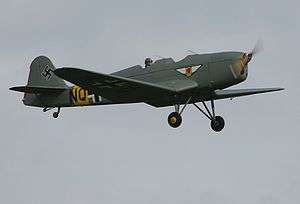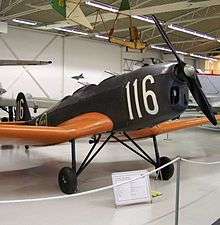Klemm Kl 35
| Kl 35 | |
|---|---|
 | |
| Klemm Kl.35D | |
| Role | Two-seat sports and training aircraft |
| Manufacturer | Klemm Leightflugzeugbau Gmbh |
| Designer | Friedrich Fecher |
| First flight | 1935 |
| Introduction | 1935 |
| Status | out of service |
| Primary users | Luftwaffe Czechoslovakia Hungary Romania Sweden |
| Produced | 1937-1944 |
| Number built | c.2,000? |
| Unit cost |
RM17,500 |
The Klemm Kl 35 is a German sporting and training aeroplane developed as a successor to the Kl 25. A product of Klemm Leichtflugzeugbau Gmbh it shared the same single-engine, cantilever low-wing configuration as the earlier machine, the major difference being the introduction of an inverted gull wing.
Probably Klemm's most important type,[1] the fully aerobatic aeroplane was shown for the first time publicly in October 1935 at the international Air Show in Milan and soon found many private buyers. Powered initially by an 80 hp (60 kW) Hirth HM60R inline,[1] it had fixed undercarriage,[1] mixed wood and fabric covering,[1] and the choice of open or closed cockpit.[1] Powered by the Hirth 60R, it became the Kl 35A (with floats, Kl 35AW),[1] while with the 105 hp (78 kW) Hirth, it was the Kl 35A (with floats, Kl 35AW).[1]
An improved Kl 35D, designed as a Luftwaffe trainer, with 105 hp (78 kW) Hirth HM 504A-2 engine and the option of ski or float landing gear, appeared in 1938.[1] It was the most numerous, with over three thousand built.[1]
A number of air forces purchased copies, including the Romanian, Hungarian, and Slovak.[1] The Swedish Air Force bought several,[1] designated Sk 15, for training use (at least five of those were seaplanes) and in 1941 began licence production, building about 74 more,[1] with some remaining in service until 1951.[1] The Lithuanian air force flew three.[1]
Development
The Kl 35 was designed in 1934 under the auspices of the Reichsluftfahrtministerium (RLM). Dipl. Ing. Friedrich Fecher had overall responsibility for the construction. The so-called Gemischtbauweise construction was used: steel for fuselage, wood for wings and tail units and only small quantities of light alloy for linings were used. This became a preferred building method with the RLM around this time, because from considerations of strategic material availability.
Production
Klemm suffered a setback in 1935 when the prototype Kl 35 crashed during testing at Rechlin. The results of further trial must have been satisfactory, because in July 1936, 23 aircraft were ordered for delivery between July and September 1937, with production planned to increase to 3 per month. Klemm was at the time manufacturing the Fw 44 under licence from Focke-Wulf.
By this time the RLM was already looking for a sub-contractor to build the Kl 35A under licence, choosing Fieseler which was already undertaking licence production of the He 72 and Fw 58 alongside Storchs at its Kasseler plant.
Further orders, to a total of 1,386, followed and new variants came on line, beginning with the Kl 35B with a new engine.
Manufacture at Fieseler ceased in November 1939, after 365 aircraft, when the RLM transferred licence production to Zlin in occupied Czechoslovakia.
Production ended in May 1943 with total production for the Luftwaffe having reached 1,302. The balance of production was for private and export customers, though since these would have to number nearly 700 to reach the oft-quoted total of around 2,000 this may be exaggerated.
Variants
- Kl 35a
- The first prototype, powered by a 60-kW (80-hp) Hirth HM60R piston engine.
- Kl-35b
- Second prototype.
- Kl 35A
- Initial production version, powered by a 60-kW (80-hp) Hirth HM60R piston engine
- Kl 35B
- Version, powered by a 80-kW (105-hp) Hirth HM504 A2 piston engine. Covered single-strut landing gear
- Kl 35BW
- Floatplane version.
- KL 35C
- Version with wooden fuselage soon renamed as Kl 106, intended for production under licence in the United States, just one built
- Kl 35D
- Improved version with triangle landing gear.
- Kl 35E
- Version powered by an improved 80-kW (105-hp) Hirth HM 500 engine
- Sk 15
- Swedish military designation for the Kl 35D.
Operators
- Czechoslovakian Air Force (Postwar)
Surviving aircraft

No Luftwaffe machine is known to survive, but a number of ex-Flygvapnet machines have been preserved.
- Klemm Kl 35B, Fv5081, Werk-Nr. 1596, 5-116, Swedish Airforce museum, Linköping S
- Klemm Kl 35D D-EFTY, Werk-Nr. 1642, the only German survivor, Fliegendes Museum, Großenhain D
- Klemm Kl 35D, SE-AKN, Werk-Nr. 1783, closed cabin, Edeby S
- Klemm Kl 35D, Fv5010, Werk-Nr. 1806, Tekniska Museet, Malmö S
- Klemm Kl 35D, D-EFUB, Werk-Nr. 1810, Winzeln-Schramberg D
- Klemm Kl 35D D-EMHN, Werk-Nr. 1842, Bad Wörrishofen D
- Klemm Kl 35D F-AZTK , Werk-Nr. 1854, ex D-EHKO F
- Klemm Kl 35D, Fv5010, Werk-Nr. 1899, 5-155, Svedinos Museum, Halmstad S
- Klemm Kl 35D, D-EDOD, Werk-Nr. 1917, ex D-ELLY, flown by Liesel Bach, Deutsches Technikmuseum Berlin D
- Klemm Kl 35D, D-EQXD, Werk-Nr. 1979, ex G-KLEM was owned and operated by Peter Holloway at Old Warden, Bedfordshire, UK. Sold to Germany, Paderborn [2][3]
- Klemm Kl 35D D-EBUX, Werk-Nr. 1981, 5-182, Fv 5052,'ex SE-BHT major overhaul since 2011, Eutingen D,
- Klemm Kl 35D SE-BGA, Werk-Nr. 1983, flew again after nearly 50 years on 19 December 2009. It is based at Håtuna, near Stockholm.[4]
Specifications (Klemm Kl 35D)
Data from The Concise Guide to Axis Aircraft of World War II [5]
General characteristics
- Crew: 2
- Length: 7.50 m (24 ft 7¼ in)
- Wingspan: 10.40 m (34 ft 1¼ in)
- Height: 2.05 m (6 ft 8¾ in)
- Wing area: 15.20 m² (163.62 ft²)
- Empty weight: 460 kg (1,014 lb)
- Max. takeoff weight: 750 kg (1,654 lb)
- Powerplant: 1 × Hirth HM 60R 4-cylinder inverted inline engine, 60 kW (80 hp)
Performance
- Maximum speed: 212 km/h (132 mph)
- Cruise speed: 190 km/h (118 mph)
- Range: 665 km (413 mi)
- Service ceiling: 4,350 m (14,270 ft)
See also
Aircraft of comparable role, configuration and era
Related lists
References
| Wikimedia Commons has media related to Klemm Kl 35. |
Notes
- 1 2 3 4 5 6 7 8 9 10 11 12 13 14 Ketley, Barry, and Rolfe, Mark. Luftwaffe Fledglings 1935-1945: Luftwaffe Training Units and their Aircraft (Aldershot, GB: Hikoki Publications, 1996), p.12.
- ↑ "Archived copy". Archived from the original on 2013-10-21. Retrieved 2013-08-16.
- ↑ Klemm Kl 35 start up
- ↑ Flypast, March 2010 p. 5
- ↑ Mondey1996, p.149-150
Bibliography
- Mondey, David. The Concise Guide to Axis Aircraft of World War II. London: Chancellor, 1996. ISBN 1-85152-966-7.
- Translated from de.wikipedia.org